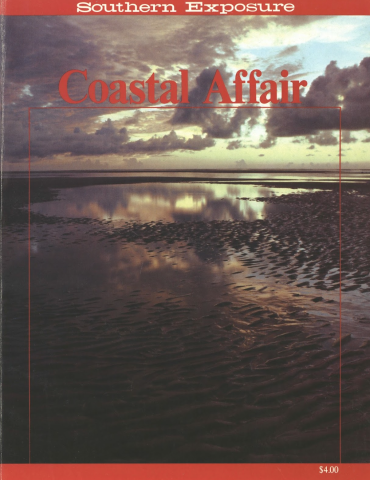Marsh Fever

This article originally appeared in Southern Exposure Vol. 10 No. 3, "Coastal Affair." Find more from that issue here.
“Muskettos are long sharp Flies, whose venom, I believe, according to their Bulk, is as Baleful as that of a Rattle Snake.” — Anonymous traveler in South Carolina, 1740s
Most residents and visitors to Southern coastlands would agree with our eighteenth-century traveler. Because the baleful mosquito also carries malaria, it has played a critical role in Southern history. Thousands of lives have been lost and millions of dollars spent on mosquito control in the South, although endemic malaria ended almost 30 years ago.
Actually, malaria was not even native to the Western Hemisphere. European colonists brought a mild form with them and, unwittingly, spread the “fever and agues” by impounding water for rice and indigo cultivation, and for millponds. By the late 1700s, all low-lying areas in the Southeast were highly malarious.
It was through the African slave trade that a particularly virulent form of malaria came to the South, yet Africans were less likely to suffer from the disease than whites. Unaware that the sickle-cell trait, common among West Africans, conveys a heightened resistance to the parasite that causes the disease, planters did notice the Africans’ resistance and promptly added it to their list of reasons why blacks “deserved” to be slaves on coastal plantations.
Throughout the nineteenth century, marshes were drained in campaigns to end the disease. The city of Savannah, for instance, spent $70,000 in 1817 to drain nearby wetlands. But not until 1897 did scientists prove the suspected link between marsh-breeding mosquitoes and the troublesome fever. The U.S. Public Health Service began serious mosquito control efforts in the South in 1912. The Army joined the battle during World War I with education, window-screening and drainage programs around military bases, and a campaign to kill mosquito larvae by spreading oil on water. After the war, the Public Health Service worked with local, state and private agencies to expand its programs, adding aerial spraying of chemicals in 1921. During the Depression, relief agencies employed thousands on massive ditching projects, draining almost 550,000 acres of Southern wetlands.
Still, malaria continued to take its toll in the South. Government studies in the 1930s assessed the monetary cost of deaths and disabilities at $500 million annually, and found malarial infections in up to 50 percent of some rural counties’ school children.
After World War II, large-scale spraying of DDT replaced more labor-intensive control methods. Through the Public Health Service’s Extended Malaria Control Program, five-percent DDT emulsions were sprayed inside rural homes and privies in virtually every Southern coastal county. These measures, combined with better health care and living conditions, ended endemic malaria in the South by the early 1950s.
Ironically, at about the time that malaria was eradicated in the South, scientists and laypeople began to recognize the harmful side-effects of mosquito control practices. In 1948 a Florida medical journal warned, “DDT is a poison to many more forms of life than just mosquitoes.” Later, Rachel Carson {Silent Spring) and other environmentalists argued successfully for a ban on DDT use in the United States.
There were other problems, too. Some misguided drainage programs actually created more mosquito breeding sites than they eliminated. And critics of drainage efforts found that early grid-ditching methods severely damaged marsh ecosystems. Private motives, not public health, kept some controversial “control” efforts alive, as one Georgia official noted in 1940: “Self-interested landowners will urge drainage of their property at public expense with little or no malaria justification.” As late as 1981, a North Carolina state report pointed out that publicly funded drainage programs were widely carried out for purposes “other than mosquito control” — such as draining farm or residential land.
Mosquito control programs also outlived the anti-malarial campaign because, in the stilted words of a 1957 government report, mosquito bites lower “physical efficiency and comfort upon which mental equanimity depends to a large degree.” To relieve coastal populations of the pest, many states rely on repetitive chemical treatments that kill adult mosquitoes; ground fogging and aerial spraying of insecticides, mostly malathion, are common practice. All told, mosquito control efforts cost the United States over $70 million annually.
For years, mosquito control officials, scientists, coastal residents and environmentalists have debated the safest, cheapest and most effective way to control mosquitoes. Years of experience in Southern and mid-Atlantic coastal wetlands, along with pressures from the environmentally concerned, led to a newer technique, less harmful to the salt marsh, called Open Marsh Water Management. A network of small ditches opens the high marsh to tidal action; permanent ponds provide access for aquatic predators to mosquito larvae.
But because the initial costs of this newer method are high, most states still rely on the quick fix — ground and aerial spraying — to control adult mosquitoes.